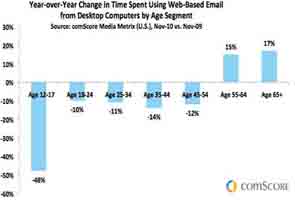- Home
- Internet
- Internet News
- E mail's big demographic divide
E-mail's big demographic divide
By Matt Richtel, The New York Times | Updated: 5 June 2012 02:22 IST

Click Here to Add Gadgets360 As A Trusted Source

Advertisement
In an article in Tuesday's Times, I wrote about the changing status of e-mail. Once it was cool to merely have an e-mail account (or several), but many young people now think of it as old school, and much prefer the zip of texting, instant messaging and social networks. (Read: E-mail gets an instant makeover)
Indeed, a deeper look at the statistics shows just how much personal e-mail use divides along generational lines.
In the last year, time spent using e-mail sites like Yahoo and Hotmail has fallen 48 percent among 12- to 17-year-olds, according to comScore, a market research firm. The statistics only include time spent with e-mail on computers, so the decline may be somewhat offset by teenagers using e-mail on their phones.
Still, the drop for that age group is far sharper than for others. ComScore found a decline of 10 percent in time spent on Web-based email among 18- to 24-year-olds, about the same as it found for people up to the age of 54.
But then things change sharply -- and start climbing in the other direction. The research firm found that time spent on e-mail rose 15 percent for people 55 to 64, and was up 17 percent for people 65 and older.
"This strongly suggests a generational shift in the way people communicate," said Andrew Lipsman, an analyst with comScore. He said the fact that people over 54 are spending more time with e-mail likely reflects the fact that some in that age group are either getting online for the first time or becoming more familiar with computers and the Internet. For them, Mr. Lipsman said, e-mail is often a starting point.
"It's usually one step at a time," he said, noting that this group is not likely to jump from the postal service to texting: "You don't go from the most formal to the least formal in one step."
Mr. Lipsman, supporting ideas expressed by others in the story, said the shift isn't just generational but situational. As people get into the workplace, he said, they tend to use e-mail more often. Besides, he said, those in the workplace -- unlike younger people -- may find the constant ping of incoming texts and IMs to be more annoying than stimulating.
"Teenagers may have more time and fewer responsibilities, so that instant communication doesn't represent a disruption to people in most cases," he said. Besides, "digital natives are used to that always-on, constant communication."
Indeed, a deeper look at the statistics shows just how much personal e-mail use divides along generational lines.
In the last year, time spent using e-mail sites like Yahoo and Hotmail has fallen 48 percent among 12- to 17-year-olds, according to comScore, a market research firm. The statistics only include time spent with e-mail on computers, so the decline may be somewhat offset by teenagers using e-mail on their phones.
Still, the drop for that age group is far sharper than for others. ComScore found a decline of 10 percent in time spent on Web-based email among 18- to 24-year-olds, about the same as it found for people up to the age of 54.
But then things change sharply -- and start climbing in the other direction. The research firm found that time spent on e-mail rose 15 percent for people 55 to 64, and was up 17 percent for people 65 and older.
"This strongly suggests a generational shift in the way people communicate," said Andrew Lipsman, an analyst with comScore. He said the fact that people over 54 are spending more time with e-mail likely reflects the fact that some in that age group are either getting online for the first time or becoming more familiar with computers and the Internet. For them, Mr. Lipsman said, e-mail is often a starting point.
"It's usually one step at a time," he said, noting that this group is not likely to jump from the postal service to texting: "You don't go from the most formal to the least formal in one step."
Mr. Lipsman, supporting ideas expressed by others in the story, said the shift isn't just generational but situational. As people get into the workplace, he said, they tend to use e-mail more often. Besides, he said, those in the workplace -- unlike younger people -- may find the constant ping of incoming texts and IMs to be more annoying than stimulating.
"Teenagers may have more time and fewer responsibilities, so that instant communication doesn't represent a disruption to people in most cases," he said. Besides, "digital natives are used to that always-on, constant communication."
Comments
Get your daily dose of tech news, reviews, and insights, in under 80 characters on Gadgets 360 Turbo. Connect with fellow tech lovers on our Forum. Follow us on X, Facebook, WhatsApp, Threads and Google News for instant updates. Catch all the action on our YouTube channel.
Further reading:
E-mail, demographic divide
Related Stories
Popular on Gadgets
- Samsung Galaxy Unpacked 2025
- ChatGPT
- Redmi Note 14 Pro+
- iPhone 16
- Apple Vision Pro
- Oneplus 12
- OnePlus Nord CE 3 Lite 5G
- iPhone 13
- Xiaomi 14 Pro
- Oppo Find N3
- Tecno Spark Go (2023)
- Realme V30
- Best Phones Under 25000
- Samsung Galaxy S24 Series
- Cryptocurrency
- iQoo 12
- Samsung Galaxy S24 Ultra
- Giottus
- Samsung Galaxy Z Flip 5
- Apple 'Scary Fast'
- Housefull 5
- GoPro Hero 12 Black Review
- Invincible Season 2
- JioGlass
- HD Ready TV
- Laptop Under 50000
- Smartwatch Under 10000
- Latest Mobile Phones
- Compare Phones
Latest Gadgets
- Redmi Note 15 5G
- Redmi Note 15 Pro 5G
- Redmi Note 15 Pro+ 5G
- Lava Play Max
- Poco C85 5G
- Honor Magic 8 Lite
- Jolla Phone
- Realme P4x 5G
- Asus ProArt P16
- MacBook Pro 14-inch (M5, 2025)
- OnePlus Pad Go 2
- Poco Pad M1
- Just Corseca Skywatch Pro
- Honor Watch X5
- Acerpure Nitro Z Series 100-inch QLED TV
- Samsung 43 Inch LED Ultra HD (4K) Smart TV (UA43UE81AFULXL)
- Asus ROG Ally
- Nintendo Switch Lite
- Haier 1.6 Ton 5 Star Inverter Split AC (HSU19G-MZAID5BN-INV)
- Haier 1.6 Ton 5 Star Inverter Split AC (HSU19G-MZAIM5BN-INV)
© Copyright Red Pixels Ventures Limited 2025. All rights reserved.

















